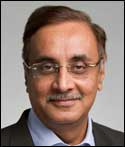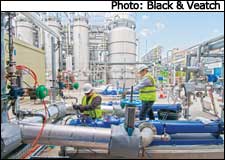 The ability to share knowledge and experience from across the globe is helping turn wastewater from problem to a resource. But first we need to change our thinking, says G. Sathiamoorthy, Managing Director, Black & Veatch, India.
The ability to share knowledge and experience from across the globe is helping turn wastewater from problem to a resource. But first we need to change our thinking, says G. Sathiamoorthy, Managing Director, Black & Veatch, India.
There are a number of trends influencing the development of wastewater treatment globally. Central to many of them, however, is the notion of wastewater as a resource.
Historically, our approach has been to throw lots of energy at wastewater treatment, especially in more affluent regions, but this is no longer sustainable. We need to change our thinking about how we treat wastewater from a problem at the end of the pipe to being a resource opportunity. There is potential to get sewage treatment plants from being energy-hungry to energy-neutral; to generate as much energy as we are using; and possibly even into positive territory so we can export energy.
We are beginning to see this in India. Ahmedabad Municipal Corporation recently approved a proposal to sell gas generated at Pirana WwTW (waterwater treatment works). Previously, the gas was flared off as a waste product. The new Kondli WwTW, built for the Delhi Jal Board, has the reported ability to generate 2 MW of power.
Even in the fossil fuel rich Gulf Cooperation Council states of the Middle East, the potential of biogas is being looked at. Taqa, Abu Dhabi’s National Energy Company, for example, is among those investigating the use of biogas from wastewater as a fuel for electricity generation.
Anaerobic digestion
The UK is a world leader in anaerobic digestion and has taken biogas use a step further with techniques such as thermal hydrolysis that increase efficiency. But more can be done with wastewater treatment, particularly on phosphate harvesting, for use in fertilisers. Black & Veatch is currently working on a new plant in Chicago, USA, to produce phosphate pellets. In the UK, Thames Water’s recently commissioned plant at Slough is the first in the country to produce phosphate pellets.
It is also possible to extract nitrogen, another fertiliser source, during wastewater treatment. We are looking to produce higher treated qualities of wastewater treatment residuals to increase water utilities’ disposal options; including developing those which represent revenue streams. The potential of projects such as these has been noted, by among others, Gujarat Chief Minister Narendra Modi. Speaking at the 2013 National Summit on Inclusive Urban Development, he announced a pilot scheme in 50 cities within the state to recover energy, water and fertiliser from waste digestion infrastructure.
The driver, globally, for technology and innovation in the wastewater sector is providing solutions that allow water utilities to find ways to service their customers and achieve better results for less. There is an environmental spin-off with this approach. Processes such as phosphate harvesting that reduce the need for chemically produced fertiliser, for example. In general, we are starting to see that if you are doing the right thing economically, you are often doing the right thing from a carbon perspective as well.

Best practice
Our company has a 60-plus strong team of water treatment experts, scattered throughout the world, who are dedicated to delivering more for less. This structure is a great opportunity to help move technology knowhow round the world to make sure that best practice is globally applied.
An example of this is tackling nutrient pollution. Nutrient limits in the US are much lower than those in the UK. In the US, the Chesapeake Bay area strictly limits the amount of nitrogen, phosphorus, and sediment pollution discharged into the bay and its tributaries. In the UK we are starting to see nutrient limits, particularly phosphate, moving toward those set in the US: typical standards from 1 to 0.3mg/l or less.
We can look at some of the lessons learned on projects in the US to achieve those low standards and apply them in the UK. This knowledge transfer is not one way. Enhanced anaerobic digestion with thermal hydrolysis pre-treatment has taken off in Europe, and is now starting to boom in the US. Black & Veatch has completed four advanced digestion plants in the UK and is bringing this knowledge to bear on the first thermal hydrolysis plant in the US at Blue Plains, Washington DC.
Neither is the knowledge transfer limited to the UK and US. All of the UK advanced digestion projects, for example, have been supported by engineers from our Mumbai office; so all of their expertise in international best-practice is readily accessible for wastewater projects here in India.
There are a lot of technology offerings out there. The challenge for any utility is to work out which one fits their particular circumstances. We spend a lot of time talking to clients across the world about what technology can do for them. With first-hand experience of applying different technologies in different regions, we can explain the real picture, the advantages and disadvantages, why a particular technology might or might not be a right for a particular client.











